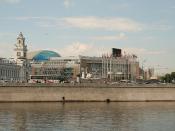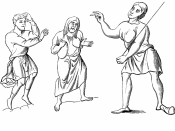Feudalism in the Middle Ages
Feudalism played a major role in the reorganization of medieval Europe. Feudalism was a disorganized political system that was based on the contracts between lords and vassals, for land and protection. Feudalism effected political, social, religious, and economical aspects of the Middle Ages.
The fall of Charlemange's Holy Roman Empire caused feudalism to emerge as the new political system in medieval Europe. The Holy Roman Empire Fell due to the Viking, Magyar and Muslim invasions and also because of the Treaty of Verdun. The Treaty was established because the grandsons of Charlemange feuded over land. The treaty divided the empire into three parts causing it to become weak and eventually to fall. Feudalism arose from the need for a protected self-sufficient manor.
There were four well-defined social classes in medieval Europe. The class you were in greatly effected your quality of life.
People were born into their classes, with the exception of peasants becoming clergy. The majority of the people were in the lower class of peasants/ serfs. The serfs were bound to the land. They lived on a lord's manor and worked their fields in return for protection. Knights were very important in feudal society. They went through many years of training to become knights. They followed the code of chivalry and protected the manor. The clergy were the only literate class. Kings, vassals, church officials, and knights were all nobility.
The church held major political power in the Middle Ages. In 590 pope Gregory I extended the power that the church had. Gregory negotiated peace treaties, and helped raise armies with the church revenues. Peasants would become monks and nuns to escape the harsh life of being a peasant. Monks and nuns lived in religious communities called monasteries. There they...


